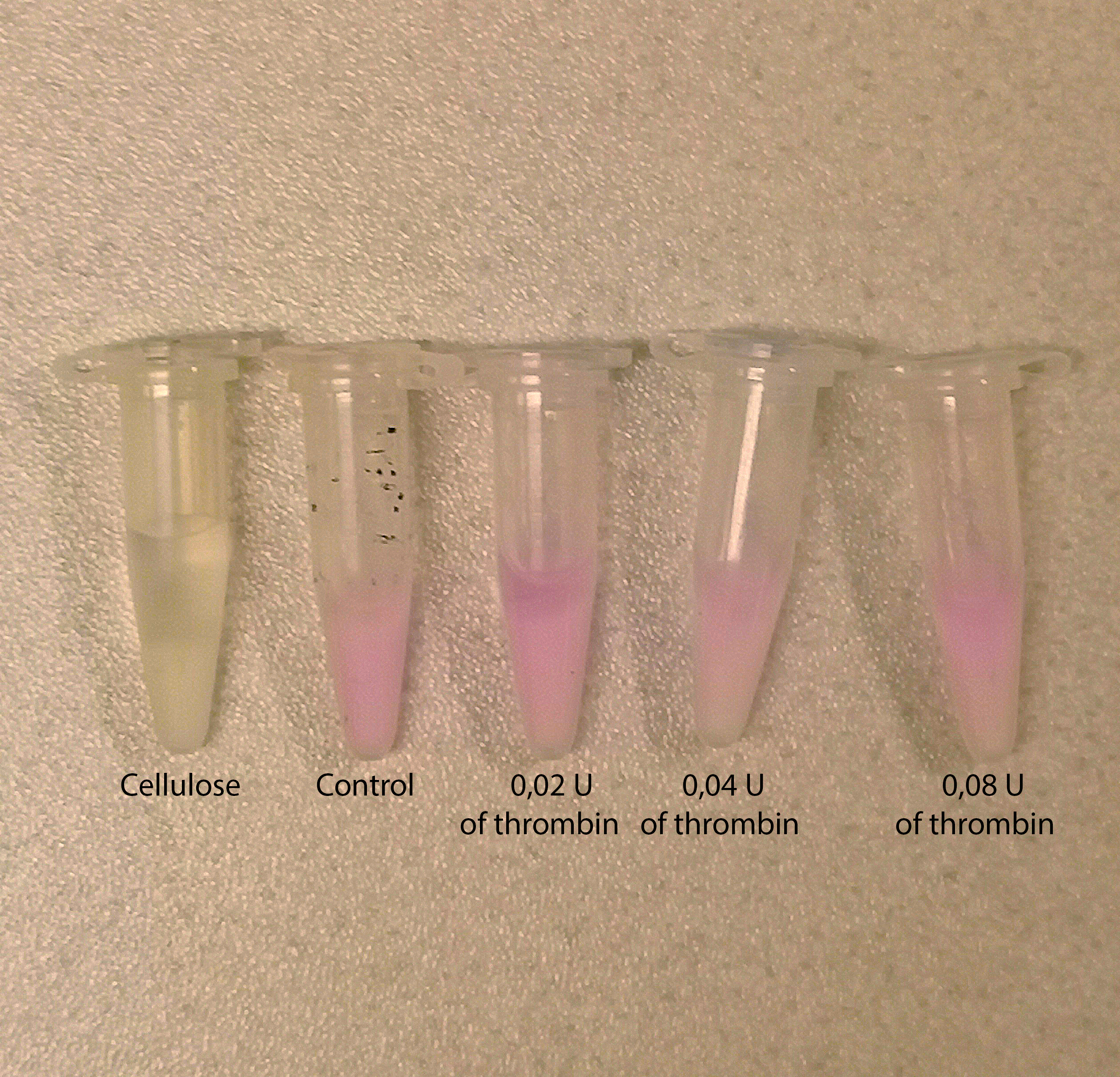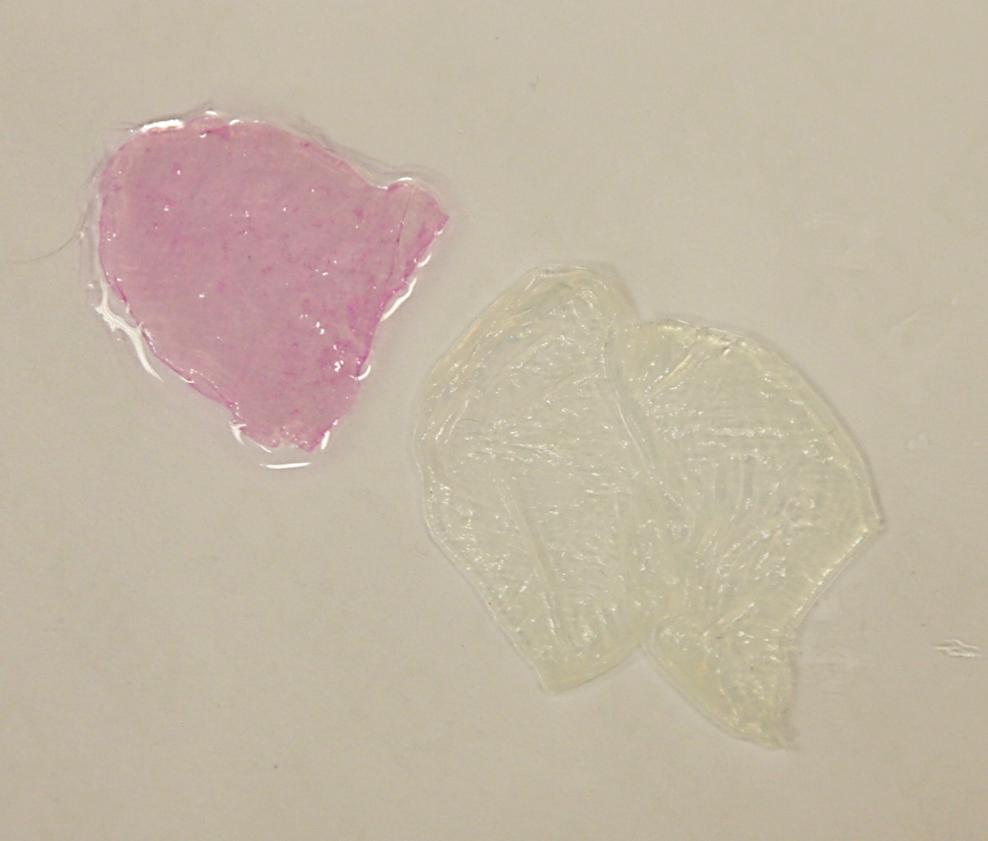Difference between revisions of "Part:BBa K3182000"
| Line 4: | Line 4: | ||
<span class='h3bb'><h1>Sequence and Features</h1></span> | <span class='h3bb'><h1>Sequence and Features</h1></span> | ||
<partinfo>BBa_K3182000 SequenceAndFeatures</partinfo> | <partinfo>BBa_K3182000 SequenceAndFeatures</partinfo> | ||
| − | |||
| − | |||
<br> | <br> | ||
<h1>Introduction</h1> | <h1>Introduction</h1> | ||
| Line 12: | Line 10: | ||
[[File:T--Linkoping_Sweden--fusionproteinillustration.jpg|420px|thumb|right|<b>Figure 1.</b> Mechanism of action. The CBDcipA-fusion is attached to cellulose. By adding thrombin from any source the fusion protein will be cleaved and the C-terminal fusion protein will be released into the solution. By changing the fusion protein to an antimicrobial peptide/enzyme, and using the cellulose as a bandage, the peptide/enzyme can be released into a wound by native human thrombin.]] | [[File:T--Linkoping_Sweden--fusionproteinillustration.jpg|420px|thumb|right|<b>Figure 1.</b> Mechanism of action. The CBDcipA-fusion is attached to cellulose. By adding thrombin from any source the fusion protein will be cleaved and the C-terminal fusion protein will be released into the solution. By changing the fusion protein to an antimicrobial peptide/enzyme, and using the cellulose as a bandage, the peptide/enzyme can be released into a wound by native human thrombin.]] | ||
| + | This part consists of a cellulose binding domain (CBD) from Clostridium thermocellum (C. thermocellum) cellulose scaffolding protein (CipA) and is a central part Clostridium thermocellum's cellusome. The CBD was fused to sfGFP in this part to easily track the binding capacities and to test our release mechanism. The CBD-sfGFP were fused using a flexible GS-linker (-GGGGSGGGGS-). A thrombin cleavage site (-LVPRGS-) was added to the end of the linker and its breakage will leave a glycine and serine attached to the N-terminal of the sfGFP fusion protein. | ||
| − | + | <h3>Assembly compabilities</h3> | |
| − | + | ||
An internal BamHI recognition sequence (RS) has been added to enable changeable fusion proteins. BamHI was chosen because its RS codes for glycine and serine, fitting it to the end of the thrombin site. It is also cost-effective enzyme and is unaffected by methylated DNA. | An internal BamHI recognition sequence (RS) has been added to enable changeable fusion proteins. BamHI was chosen because its RS codes for glycine and serine, fitting it to the end of the thrombin site. It is also cost-effective enzyme and is unaffected by methylated DNA. | ||
| − | |||
| − | |||
| − | <br><br><br> | + | This part can be used to track purification, measure CBD binding ability and report cleavage at the thrombin site. |
| + | |||
| + | <br><br><br><br><br><br> | ||
| + | |||
| + | <h2>CBDcipA crystal structure</h2> | ||
| + | |||
| + | [[File:T--Linkoping_Sweden--rotatingcbdanimationloop.gif|420px|thumb|left|<b>Figure 1.</b> Crystal structure of CBDcipA with a resolution of 1.75 Å which were solved by [http://www.ncbi.nlm.nih.gov/pmc/PMC452321 Tormo et al. 1989]. PDB code 1NBC. In red from the left, W118, R112, D56, H57 and Y67, thought to be the surface which interacts strongly with cellulose.]] | ||
| + | |||
| + | <h3>Important molecular faces</h3> | ||
| + | CBDcipA is composed of a nine-stranded beta sandwich with a jelly roll topology and binds a calcium ion. It further contains conserved residues exposed on the surface which map into two clear surfaces on each side of the molecule. One of faces mainly contains planar strips of aromatic and polar residues which may be the cellulose binding part. Further aspect are unknown and unique with this CBD such as the other conserved residues which are contained in a groove. | ||
| + | |||
| + | <h3>The choice of cellulose binding domain</h3> | ||
| + | iGEM Linköping 2019 choose CBDcipA due to many other iGEM teams exploring the possibilities of this domain. Our basic design was influenced by iGEM14 Imperial, iGEM15 Edinburgh and iGEM18 Ecuador. Purification and where to place the fusion protein (N- or C-terminal) was determined by studying the former projects. CBDcipA also originates from a thermophilic bacteria which further increases the domains applications. | ||
| − | |||
| − | |||
| − | |||
| − | |||
| − | + | <br><br><br><br><br><br><br><br> | |
<h2>Expression system</h2> | <h2>Expression system</h2> | ||
The part has a very strong expression with a T7-RNA-polymerase promotor (<partinfo>BBa_I719005</partinfo>) as well as a 5'-UTR (<partinfo>BBa_K1758100</partinfo>) region which has been shown to further increase expression in E. coli (<partinfo>BBa_K1758106</partinfo>), ([http://www.ncbi.nlm.nih.gov/pubmed/2676996 Olins et al. 1989]), ([http://www.ncbi.nlm.nih.gov/pubmed/23927491 Takahashi et al. 2013]). Both this part and the part were sfGFP was changed for AsPink (<partinfo>BBa_K3182000</partinfo>) showed great expression. | The part has a very strong expression with a T7-RNA-polymerase promotor (<partinfo>BBa_I719005</partinfo>) as well as a 5'-UTR (<partinfo>BBa_K1758100</partinfo>) region which has been shown to further increase expression in E. coli (<partinfo>BBa_K1758106</partinfo>), ([http://www.ncbi.nlm.nih.gov/pubmed/2676996 Olins et al. 1989]), ([http://www.ncbi.nlm.nih.gov/pubmed/23927491 Takahashi et al. 2013]). Both this part and the part were sfGFP was changed for AsPink (<partinfo>BBa_K3182000</partinfo>) showed great expression. | ||
| − | [[File:T--Linkoping_Sweden--expression.png|900px|thumb|center|<b>Figure | + | [[File:T--Linkoping_Sweden--expression.png|900px|thumb|center|<b>Figure B.</b> Benchling screenshot of the expression system. The T7-RNA-polymerase promotor is followed by a T7 g10 leader sequence which enhances the binding to the 16S ribosomal RNA. After the leader sequence a poly A spacer is found, which has been shown to increase translation in vitro. Before the start codon a strong RBS, g10-L, followed by an AT-rich spacer can be seen, which will slightly increase translation of the following gene.]] |
<h1>Usage and Biology</h1> | <h1>Usage and Biology</h1> | ||
Revision as of 08:30, 6 September 2019
Contents
Sequence and Features
- 10COMPATIBLE WITH RFC[10]
- 12COMPATIBLE WITH RFC[12]
- 21INCOMPATIBLE WITH RFC[21]Illegal BamHI site found at 580
- 23COMPATIBLE WITH RFC[23]
- 25COMPATIBLE WITH RFC[25]
- 1000COMPATIBLE WITH RFC[1000]
Introduction
pT7-CBDcipA-AsPink

This part consists of a cellulose binding domain (CBD) from Clostridium thermocellum (C. thermocellum) cellulose scaffolding protein (CipA) and is a central part Clostridium thermocellum's cellusome. The CBD was fused to sfGFP in this part to easily track the binding capacities and to test our release mechanism. The CBD-sfGFP were fused using a flexible GS-linker (-GGGGSGGGGS-). A thrombin cleavage site (-LVPRGS-) was added to the end of the linker and its breakage will leave a glycine and serine attached to the N-terminal of the sfGFP fusion protein.
Assembly compabilities
An internal BamHI recognition sequence (RS) has been added to enable changeable fusion proteins. BamHI was chosen because its RS codes for glycine and serine, fitting it to the end of the thrombin site. It is also cost-effective enzyme and is unaffected by methylated DNA.
This part can be used to track purification, measure CBD binding ability and report cleavage at the thrombin site.
CBDcipA crystal structure
Important molecular faces
CBDcipA is composed of a nine-stranded beta sandwich with a jelly roll topology and binds a calcium ion. It further contains conserved residues exposed on the surface which map into two clear surfaces on each side of the molecule. One of faces mainly contains planar strips of aromatic and polar residues which may be the cellulose binding part. Further aspect are unknown and unique with this CBD such as the other conserved residues which are contained in a groove.
The choice of cellulose binding domain
iGEM Linköping 2019 choose CBDcipA due to many other iGEM teams exploring the possibilities of this domain. Our basic design was influenced by iGEM14 Imperial, iGEM15 Edinburgh and iGEM18 Ecuador. Purification and where to place the fusion protein (N- or C-terminal) was determined by studying the former projects. CBDcipA also originates from a thermophilic bacteria which further increases the domains applications.
Expression system
The part has a very strong expression with a T7-RNA-polymerase promotor (BBa_I719005) as well as a 5'-UTR (BBa_K1758100) region which has been shown to further increase expression in E. coli (BBa_K1758106), ([http://www.ncbi.nlm.nih.gov/pubmed/2676996 Olins et al. 1989]), ([http://www.ncbi.nlm.nih.gov/pubmed/23927491 Takahashi et al. 2013]). Both this part and the part were sfGFP was changed for AsPink (BBa_K3182000) showed great expression.

Usage and Biology
AsPink bound to cellulose bandage
Epiprotect (microbial cellulose bandage, S2Medical) was incubated in AsPink lysate from BL21 (DE3) Gold for 30 min. Epiprotect was later washed with 70% ethanol three times. To the left is AsPink incubated Epiprotect and to the right is plain Epiprotect.

Thrombin Cleavage
In figure 9 bacterial lysate of sonicated E. coli BL21 was incubated with cellulose (Whatman CF-11 Fibrous Medium Cellulose Powder) in 1h on an end-to-end rotator at R.T. The cellulose was saturated with AsPink lysate. The samples were afterwards centriuged at 3000 g in 1 min and the supernatant was removed. In all samples cleavage buffer (20 mM Tris-HCl pH 8.4, 150 mM NaCl and 2.5 mM CaCl₂) was added and three different dilutions of thrombin (Novagen, #69671) was added. The dilutions were 0,02, 9,94 and 0,08 units (U). One unit refers to the amount of thrombin needed to cleave 1 mg of protein for 16h at R.T in a 200 µl reaction containing the cleavage buffer. The samples were put on an end-to-end rotator over-night (ca 16h) and left at R.T. The control with only cleavage buffer has a transparent supernatant and a pink pellet of cellulose, the most diluted (0,02 U) has a slightly pinker supernatant and less pink pellet however the 0,04 U and 0,08 U dilutions has a pinker supernatant and paler pellet with 0,08 U dilution being the sample with most cleaved AsPink due to the more intense supernatant.





